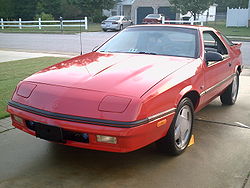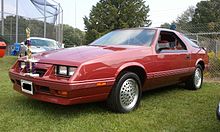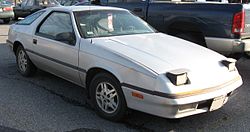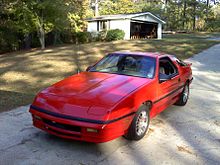- Dodge Daytona
-
This article is about 1980s and 1990s hatchbacks. For B-body and LX-platform variants, see Dodge Charger Daytona. For truck variant, see Dodge Ram Daytona.
The first car that carried the Daytona name was a sporty version of the Studebaker Lark which was produced from 1963 to 1966 with standard bucket seats and available with an optional Studebaker Avanti V8 high-performance engine.
Dodge Daytona Manufacturer Chrysler Corporation Production 1984–1993 Assembly St. Louis, Missouri, United States
Sterling Heights, Michigan, United StatesPredecessor Dodge Challenger Successor Dodge Avenger Class Compact Body style 3-door hatchback Layout FF layout Platform G-body Engine 2.2 L K I4
2.2 L Turbo I I4
2.2 L Turbo II I4
2.2 L Turbo III I4
2.5 L K I4
3.0 L Mitsubishi 6G72 V6Transmission 5-speed manual
3-speed automatic
4-speed automaticWheelbase 1987–89: 97.0 in (2,464 mm)
1990–93: 97.2 in (2,469 mm)Length 1987–1991: 179.2 in (4,552 mm)
1990–93 ES & IROC: 179.8 in (4,567 mm)
1992–93 Base: 179.0 in (4,547 mm)Width 69.3 in (1,760 mm) Height 1987–89: 50.1 in (1,273 mm)
1990–93: 50.3 in (1,278 mm)
1990–91 IROC & 1992–93 IROC R/T: 50.6 in (1,285 mm)
1992–93 IROC: 50.4 in (1,280 mm)Related Chrysler Laser
Chrysler GSThe Dodge Daytona was a front-wheel drive hatchback based on the Chrysler G platform, which was derived from the Chrysler K platform. The Daytona was produced from 1984 to 1993. The Chrysler Laser was an upscale near twin version of the Daytona. The Daytona was restyled for 1987, and again for 1992. It replaced the Mitsubishi-based Challenger, and slotted between the Charger and the Conquest. The Daytona was replaced by the 1995 Dodge Avenger, which was built by Mitsubishi Motors. The Daytona derives its name mainly from the Dodge Charger Daytona, which itself was named after the Daytona 500 race in Daytona Beach, Florida.
Contents
History
The Daytona originally used the 2.2 L Chrysler K engine in normally aspirated (93 hp) or turbocharged (142 hp) form. The 96 hp 2.5 L K engine was added for 1986. In 1985, the 2.2 L Turbo I engine's horsepower was increased to 146 hp (109 kW). The 1984 Daytona was available in three trim lines: standard, Turbo and Turbo Z. Total production was 49,347. The Daytona Turbo was on Car and Driver magazine's Ten Best list for 1984. Both the Daytona and Chrysler Laser were available with the Chrysler Electronic Voice Alert system through 1987. A performance oriented "Shelby" version of the Daytona was introduced in 1987.
Chrysler Laser
The Chrysler Laser was billed as the Chrysler brand's first sports car. The Laser was a virtual clone of the Dodge Daytona, but came only in the upscale trim version. It was produced from 1984 to 1986. The Laser emphasized European luxury, and was intended to be an "executive personal luxury coupe." The Laser was sleek, low-slung, and aerodynamic, with a drag coefficient of only .35. The car had a large rear hatchback, with a rear deck-lid spoiler. The 1984 Laser was available in two trim lines: standard and XE. In mid-1985, the XT trim was added as the top-of-the-line version. The standard, XE and XT trim lines would continue until the Laser’s demise in mid-1986. After 1986, the Daytona was exported to Canada as the Chrysler Daytona, officially ending Canadian Daytona sales under the Dodge marque. The turbo version of the Laser could be recognized by its use of black hood louvers. The 2.2 L Turbo I engine was available as standard equipment in the XE and XT trim lines and optional on the standard model. The Laser was intended to replace the Chrysler Conquest, a rear wheel drive vehicle which competed directly against the Toyota Celica Supra. The Laser name was silently terminated after the first half of 1986 model year, then resurrected for the 1989/1990 model year with as the Plymouth Laser, built by Diamond Star Motors, a joint venture between Chrysler and Mitsubishi. The rebranded Laser shared its chassis with the Eagle Talon and Mitsubishi Eclipse.
In 1987, the Chrysler LeBaron was restyled as a more proper sports car, removing Chrysler's need for the Laser. However, the Laser’s luxury performance image would be carried over into the 1987 Dodge Daytona Pacifica as well as the Lancer Pacifica and other Dodge vehicles styled by Chrysler's Pacifica Studios.
The Laser was specified to have an estimated 22 mpg-US (11 L/100 km; 26 mpg-imp) city/35 mpg-US (6.7 L/100 km; 42 mpg-imp) highway fuel mileage. Chrysler offered a 5 year or 50,000-mile (80,000 km) warranty, or a Protection Plan with outer body rust-through protection, based on United States Automobile Club tests. Mark Cross leather seats and a six-way power options were available as options.
Notable features of the Chrysler Laser XE:
- A dashboard with digital readouts for the speedometer, tachometer, odometer, temperature, oil pressure, voltage, and fuel.
- An electronic monitoring system, situated near the top of the center console. This monitoring system checked 22 separate functions on the car, such as an open door, low fuel, or a blown taillight, and would give a digital readout of the situation, along with an audio message made by a synthesized voice.
- An electronic navigator, which would give information on mileage, miles traveled, distance to destination, and elapsed driving time.
Production numbers
- 1984 - 59,858 (Laser- 33,976/Laser XE- 25,882)
- 1985 - 50,866 (Laser- 29,221/Laser XE- 18,193/Laser XT- 3,452)
- 1986 - 36,672 (Laser- 14,134/Laser XE- 15,549/Laser XT- 6,989)
1984
The Daytona debuted with a 142 hp turbo 1 motor. Many turbo z models were produced and more luxurious than other years because of the mark cross leather interiors, light up speakers, and rear amp switches. These options were dropped after 1984
1985
Changes were minimal for the Daytona's second year of production. The Turbo Z model was no longer listed as a package but was now a model in its own right. The wrap-around spoiler, formerly exclusive to the Turbo Z model, was now offered on all three models. But the biggest change was under the hood: the 2.2 Turbo was given 4 more hp to 146 hp (109 kW), and a new shift linkage was added. Optional "Swiss cheese" wheels were replaced with new optional "Pizza" wheels. All wheels now had five lug nuts (instead of four) Total production was 47,519.
1986
There were changes for the 1986 Daytona. The middle "Turbo" model was dropped, leaving just two models: Base and Turbo Z. Engine changes were also made: A new 2.5 L 100 hp (75 kW) 4-cylinder engine was added for the base model. A new t-roof package was added to the option list, but just 5,984 Daytona owners chose this option. The biggest addition was the optional C/S (Competition Series). This consisted of 32 mm (1.3 in) front and 28 mm (1.1 in) rear anti-sway bars, performance tuned struts, and speed rated tires. This package would foreshadow the Daytona Shelbys of 1987 and beyond. Only 7,704 owners added this handling package to their Daytonas. Total production this year would be 44,366.
1987–1988
In 1987, the Daytona was restyled externally, and featured pop-up headlights. New in 1987 was a Shelby Z trim level with an available Turbo II (174 hp (130 kW) - 200 lb·ft (271 N·m)) intercooled version of the 2.2 L Chrysler K engine, as well as a heavy-duty A555 transaxle with Getrag gears. The Shelby Z also featured numerous suspension upgrades, including a larger diameter front sway bar and rear disc brakes. This version was sold in Europe under the name Chrysler GS Turbo II. A more luxury-oriented Pacifica trim line was also added to replace the Chrysler Laser, which was dropped by mid-year 1986. Among the standard and optional equipment: leather interior, an 8 way power enthusiast drivers seat (with mechanical Thigh/Lumbar controls), digital dash, 12 button navigator (with instant fuel ratings as well as trip averages and estimated travel times), among several other features. In 1988, the C/S package was revived. However, this time the C/S was available only on the base model Daytona. In order to cut weight and make a lighter Daytona, the C/S came without the ground effects and other elegant features that were featured on the Shelby. The AGB model C/S featured a turbo I 2.2 liter engine, which was available in both automatic and manual transmissions.
Decepzione
Following the Chrysler takeover of Lamborghini, product programs general manager Jack Stavana introduced a program to fit a Lamborghini Jalpa V8 into a Daytona. The motor was linked to an all-wheel drive (AWD) system designed by Carroll Shelby, and the car was called the Decepzione. Despite its performance and media buzz generated by articles in Car and Driver magazine, the project was discontinued due to the engine's oil pan having just 1.5 inches (38.1 mm) of ground clearance, necessitated by the comparatively tall engine block.
1989–1991
1989 considered by most as the best looking year of all Daytonas saw a big sales increase. 1989 also had a new ground effects package for the Shelby that really stood out with 4,741 being produced. Silver being the rarest with only 258 being made. Future collectors take notice of any silver or black daytona shelbys because of their broad appeal.1989 saw the introduction of the ES model offered with silver contrasting ground affects, along "snowflake" patterned rim design. ES was offered as an appearance package/equipment group on base models in order to attract the "average" Daytona buyer’s eye without a major price hike. Also introduced in 1989 was the AGS C/S model, which was featured along with the regular AGB model. This new model of C/S featured an intercooled turbo II engine, along with many other features that were also on the Shelby. However, this model was only available with a manual transmission. The AGS C/S package would remain in availability until 1991.
In 1990, all Daytonas received an interior restyling, featuring a more modern-feeling cockpit style wraparound dashboard. Also introduced in 1990, a Variable Nozzle Turbocharger (VNT Turbo IV) was offered in the Shelby model producing the same 174 hp (130 kW) as the Turbo II but, it reduced turbo lag and improved driveability. Chrysler dropped the package citing problems with the turbocharger. Also for 1990 a 3.0 L SOHC V6 from Mitsubishi was made available, as well as a redesigned interior similar to that of the Chrysler LeBaron coupe and convertible. In addition, 1990 saw the introduction of a standard driver's side airbag to the Daytona. This was in keeping with Chrysler's decision to offer a driver's side airbags across most models. 1991 saw the addition of an IROC model with the turbocharged 2.5 L engine, and the 2.2 L engine was dropped. Visually, Iroc models differed from lesser models, having a ground effects kit and alloy wheels, among other differences. The Iroc Decals where added in halfway through 1991 even though all Shelby Daytona's from 1991 where considered to be an "IROC", which could be revealed if one looked up their VIN # online. There are no difference between a 91 Shelby and Iroc besides the decals and the J in the vin sequence. On 1991 model Daytona Shelbys the vin had the sequence `G74J` and the Iroc's had the sequence G743. Over the years people have added the wrong shelby or iroc decals to their cars, one way to correct this is to check the vin sequence to determine what model it is.
1992–1993
Production was moved from the St. Louis, Missouri plant to the Sterling Heights, Michigan plant. This second Daytona restyling replaced the pop-up headlights with flush-mounted rounded ones, along with a new grille and rear fascia. Window surround moldings on the doors were also new, and rounder than the sharper angles of moldings on the 1984 to 1991 models. The new model also displayed the new Dodge ram's head emblem on the hood and below the read light. While 6 cylinder power became an option on lower end models, the 3.0 L Mitsubishi V6 was the standard engine on IROC models. Optional on the 1992 IROC was the 2.5l "High Torque" Turbo, available as a very rare option (less than 230 produced). Also available on Iroc was the new 'R/T' performance package, which featured a 224 hp (167 kW) Turbo III version of the 2.2 L 4 cylinder, but with a Lotus designed DOHC cylinder head and direct ignition system instead of a distributor-type ignition system. Although the Shelby trim was discontinued in 1991 (due to the end of Shelby's involvement with Chrysler), a small number of Irocs were produced bearing the Shelby name. These Irocs featured "Shelby" decals, and were all 2.5 Turbo cars, as they featured the Shelby Performance Package sales code. These rare Shelby versions were mainly "Chrysler" branded Daytonas, and were part of an early run of Irocs. These were the last production vehicles produced by Chrysler Corp to bear the Shelby name. Production of the Daytona ended on March 2, 1993, and the Daytona was replaced by the 1995 Dodge Avenger. Today the Dodge Daytona, along with many other turbocharged Chrysler vehicles, has developed a sort of cult following, remaining popular among its own group of followers because of its durable engine, which can be easily modified to put out large quantities of power at relatively low cost and ease.
External links
- TurboMopar Discussion Forum
- Allpar.com Daytona/Laser page
- What's It Like To Drive - Describes a test between two Dodge Daytonas, one FWD and one RWD
- Front-Runners.net - Daytona Road Test pdf
Dodge Cars Vans / SUVs Historic 024 · 330 · 400 · 600 · 880 · Aries · Aspen · Avenger · Brisa · Caliber · Challenger · Charger (B-body) · Charger (L-body) · Charger Daytona · Colt · Conquest · Coronet · Custom 880 · Dart · Daytona · Demon · Diplomat · Dynasty · Intrepid · La Femme · Lancer · Matador · Mirada · Monaco · Neon · Omni · Phoenix · Polara · SE · Shadow · Sierra · Spirit · SRT-4 · St. Regis · Stealth · Stratus · Super BeeHistoric Vans / SUVs Corporate Fratzog · John Francis Dodge · Horace Elgin Dodge · Ram Truck Division · Category:Dodge vehicles · Chrysler LLC« previous — Dodge road car timeline, United States market, 1980s–present Type 1980s 1990s 2000s 2010s 0 1 2 3 4 5 6 7 8 9 0 1 2 3 4 5 6 7 8 9 0 1 2 3 4 5 6 7 8 9 0 1 2 Subcompact Omni Colt Colt Colt Colt Omni 024 Charger Compact Colt 400 Shadow Neon Neon Caliber Aspen Aries Mid-size Lancer Mirada 600 Spirit Avenger Diplomat Dynasty Stratus Stratus Full-size St. Regis Monaco Intrepid Intrepid Magnum Charger Charger Sport compact Daytona Avenger SRT-4 Sports Challenger Conquest Stealth Challenger Viper Viper Viper Viper Categories:- Dodge vehicles
- Front wheel drive vehicles
- Front wheel drive sports cars
- Sports cars
- Hatchbacks
- 1980s automobiles
- 1990s automobiles
- Vehicles introduced in 1984
Wikimedia Foundation. 2010.






